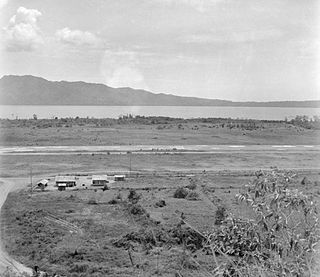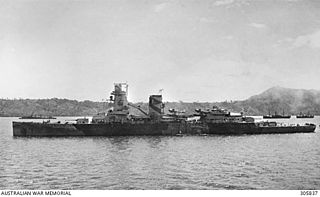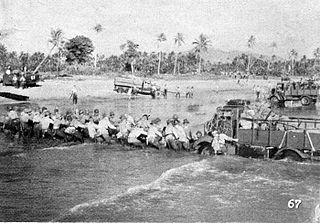 W
WThe Battle of Ambon occurred on the island of Ambon in the Dutch East Indies, during World War II. Japan invaded and conquered the island in a few days, facing Dutch, American and Australian forces. The chaotic and sometimes bloody fighting was followed by a series of major Japanese war crimes.
 W
WThe Battle of Badung Strait was a naval battle of the Pacific campaign of World War II, fought on the night of 19/20 February 1942 in Badung Strait between the American-British-Dutch-Australian Command (ABDA) and the Imperial Japanese Navy. In the engagement, the four Japanese destroyers defeated an Allied force that outnumbered and outgunned them, sinking the Dutch destroyer Piet Hein and escorting two transports to safety. The battle demonstrated the Japanese Navy's considerable superiority over the Allies in night fighting which lasted until the Battle of Cape St. George.
 W
WThe Battle of Banjarmasin took place as part of the Japanese offensive to capture the Dutch East Indies. The Japanese conducted a pincer attack from sea and land to capture a strategic airfield in Banjarmasin in preparation for the capture of Java Island.
 W
WThe Battle of Makassar Strait, also known as the Action of Madura Strait, the Action North of Lombok Strait and the Battle of the Flores Sea, was a naval battle of the Pacific theater of World War II. An American-British-Dutch-Australian (ABDA) fleet—under Schout-bij-nacht Karel Doorman—was on its way to intercept a Japanese invasion convoy reported as bound for Surabaya, when it was attacked by 36 Mitsubishi G4M1 "Betty" and 24 Mitsubishi G3M2 "Nell" medium bombers, which forced the fleet to retreat.
 W
WThe Battle of Samarinda was a mopping up operation in the series of the Japanese offensive to capture the Dutch East Indies. After capturing the oil refineries at Balikpapan, Japanese forces advanced north to capture the strategic oil drilling site in and around Samarinda and the oil pipelines that linked both cities.
 W
WThe Battle of Tarakan took place on 11–12 January 1942, a day after the Empire of Japan declared war on the Kingdom of the Netherlands. Although Tarakan was only a small marshy island off northeastern Borneo in the Netherlands East Indies, its 700 oil wells, refineries, and airfield made it a crucial objective for Japan in the Pacific War.
 W
WThe Battle of Borneo was a successful campaign by Japanese Imperial forces for control of Borneo island and concentrated mainly on the subjugation of the Raj of Sarawak, Brunei, North Borneo, and the western part of Kalimantan that was part of the Dutch East Indies. The Japanese main unit for this mission was the 35th Infantry Brigade led by Major-General Kiyotake Kawaguchi.
 W
WThe Dutch East Indies campaign of 1941–1942 was the conquest of the Dutch East Indies by forces from the Empire of Japan in the early days of the Pacific campaign of World War II. Forces from the Allies attempted unsuccessfully to defend the islands. The East Indies were targeted by the Japanese for their rich oil resources which would become a vital asset during the war. The campaign and subsequent three and a half year Japanese occupation was also a major factor in the end of Dutch colonial rule in the region.
 W
WThe Invasion of Sumatra was the assault by Imperial Japanese forces on the Dutch East Indies that took place from 14 February to 28 March 1942. The invasion was part of the Pacific War in South-East Asia during World War II and led to the capture of the island. The invasion of Sumatra was planned to occur prior to the invasion of Java to destroy the west flank of the allies and to give access to Java.
 W
WLobang Jepang or Lubang Jepang, which means Japanese tunnel is an underground military complex, which is now one of the historical tourist attraction in the city of Bukittinggi, West Sumatra in Indonesia. The Japanese tunnel is a protection tunnel built by the Japanese occupying army around 1942 for defense purposes, which was fully completed in June, 1944. It was first discovered in the early 1950s and opened to the tourists in 1994. As is known, during World War II in 1942 Japanese occupied force had begun to be pressured by Allied forces, and started to construct many hiding tunnels across the archipelago of then Dutch East Indies, not only in Bukittinggi, but also in cities of Bandung and Biak, as well as other places in Indonesia.
 W
WThe Battle of Manado took place as part of the Japanese offensive to capture the Dutch East Indies. It occurred at Manado on the Minahasa Peninsula on the northern part of Celebes Island, from 11–12 January 1942. The battle was noted as the first time in Japanese history that the country had deployed paratroopers in a military operation.
 W
WThe Battle of Palembang was a battle of the Pacific theatre of World War II. It occurred near Palembang, on Sumatra, on 13–15 February 1942. The Royal Dutch Shell oil refineries at nearby Pladju were the major objectives for the Empire of Japan in the Pacific War, because of an oil embargo imposed on Japan by the United States, the Netherlands, and the United Kingdom after the Japanese invaded China and committed massive atrocities such as the rape of Nanking. With the area's abundant fuel supply and airfield, Palembang offered significant potential as a military base to both the Allies and the Japanese.